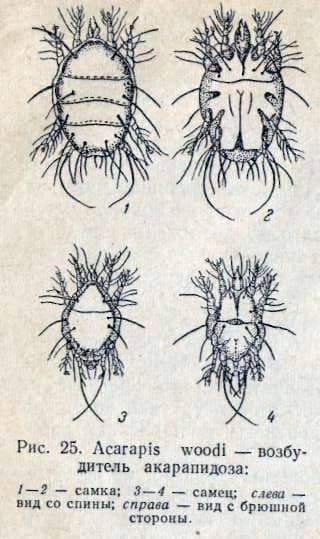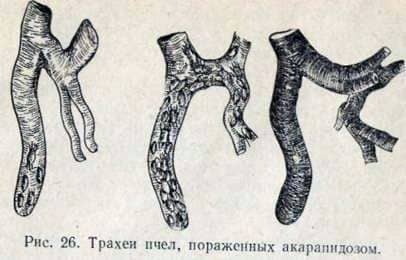
Acarapidosis (tick disease, acarosis, White’s disease) is an invasive disease of bee colonies, which causes tracheal injury.
Economic damage. Disease in winter and spring causes weakening and death of bee colonies; spreads slowly, first weak, and then much harm to the apiaries.
The causative agent of the disease is Acarapis woodi mite. The tick is parasitic in the trachea of adult bees. Female size 190-160×80-110 microns, male-85-120×60-80 microns.

The shape of the tick is oval, oblate. The tick has four pairs of legs, consisting of six segments. In females and males, the first three pairs of legs are arranged identically, and each limb of the fourth pair in females ends with four hairs, two of which are short, and two long, in males – with one short spike and a long hair.
Mites are collected in the trachea of the bee. Female 3-4 days after fertilization lays 4-10 rather large eggs, the size of which is 60-65 x 120-140 microns. After 4-5 days, larvae of 100-120×200-220 microns hatched from eggs. Larvae have three pairs of legs, of which only the first pair is well developed and has on each leg two claws and a scutum between them.
An eight-legged nymph develops from the larva, which differs from an adult tick only in that its skin is not divided by a visible groove; The nymph is mobile, it resets its outer cover and turns into an adult mite. The general development of the female tick lasts 11-16 days, and the male – 10-13 days; females hatch 2-3 times more than males. The chewing organs of an adult mite are cylindrical in shape, inside of which there are two setae. Movement of their forward is provided by two muscles – extensors. When feeding, both bristles with great force dig into the tissues of the bee, which allows the mite to feed on its hemolymph.
The habitat of the mites is the first pair of thoracic trachea, where the mites fall exclusively through the first pair of thoracic spiracles (stigma). The large cross-sectional dimensions of these holes allow the mites to penetrate only through them; other spiracles are not accessible for the penetration of ticks due to too narrow slotted holes and dense hairs around them.
The tick also settles at the base of the wings, where chitin is weaker, it can pierce it, feed on hemolymph and multiply. Larvae can also pierce the chitin at the articulation of the wing.
The tick in the external environment is extremely unstable. In the trachea of a dead bee, mites can live no more than 5-6 days. Ticks in corpses are practically no longer dangerous to other bees.
The tick is a typical endoparasite, it is contagious for adult bees, queens and drones; eggs, larvae and pupae of bees do not become infected with mites.
Epizootic data. The development of the disease occurs by contact slowly in connection with the gradual reproduction of ticks in the family. Since the infection of one bee prior to infection in the family, 50% of the bees are 3-5 years old, and only when the infection reaches 50% of the bees of the family and above, the first signs of the disease appear. During the first 3-5 years of asymptomatic development of the disease, a number of other families of the same, and often other apiaries, manage to get infected from this family.
The spread of the disease from family to family occurs mainly with the natural and artificial swarming of the bees, as well as the wandering of bees and drones. From some apiaries to other diseases spread mainly through swarming.
The most common distribution of acarapidosis from one apiary to another occurs in the uncontrolled sale of bees and queens, while exporting bees from areas known to be acutely ill in acarapidosis to others that are free from this disease.
The ill family does not recover, sooner or later it dies.
The course and symptoms of the disease. The course of the disease is chronic. It can flow in an explicit and hidden form. In latent form, the disease occurs during the first few years after infection of the bees. This form of the disease often remains undetected, even with a special all-purpose survey of all families in the apiary.
The apparent form of the disease appears much later, when sick bees in the family are about one-third, half or more. The speed of the transition of the latent form of the disease to the apparent great influence exerted by external conditions.
The disease is most strongly manifested in geographical latitudes from 70 to 40 њ N in regions with a humid climate.
The most vivid signs of the disease appear on the day of the spring exhibition of bees from winter premises, and in summer after prolonged inclement weather. Bees of sick families when flying out of the hive fall to the ground, where they crawl by hundreds and thousands. The wings of diseased bees are set apart, incorrectly folded, as if turned out.
The diagnosis is based on the studies of the anterior pair of tracheas under a microscope. Trachea in patients with bees under the influence of nubs and exhaustion from the body of the bee hemolymph acquire at first yellow, then brown, and later almost black. In addition, in the trachea are found ticks in different stages of development.

Prevention is reduced to preventing drift of the causative agent of acarapidosis to safe apiaries. The most dangerous path of infection of healthy apiaries is through the acquisition of bees from the side. Unsuccessful for acarapidosis apiaries are kept in strict account. They can not sell families (swarms), as well as queens.
Annually spend an early spring on the day of the spring exhibition survey bee colonies on acarapidosis. At the same time pay attention to the behavior of bees. If it turns out that in some families the mass of bees shows inability to fly and almost completely covers the ground, creeps near the hives, then it is necessary to take the material (from 3-5 families to 50 bees from each) and send it to the veterinary laboratory for research.
Control measures. Acarapidosis is a dangerous disease, and it is not enough to fight it with just one treatment. Treatment is an auxiliary measure that does not provide a complete recovery of families. It gives only partial success, and therefore it must be repeated on the same apiary from year to year.
Because of the imperfection of modern diagnostics of acarapidosis, it is impossible to identify all sick families. If there is a family in the apiary, in which acarapidosis is confirmed by laboratory testing, the remaining families of the apiary are suspicious of this disease. In this case, the quarantine is imposed not only on the apiary, unsuccessful for acarapidosis, but also on all apiaries that are within a 5 km radius.
Quarantine is removed after complete elimination of the disease. Until the complete elimination of acarapidosis, the boundaries of the spread of the disease are accurately identified and all families within the identified foci of the disease are destroyed. Such measures can be carried out by decision of the regional or district executive committees of the Soviets of Working People’s Deputies. The losses of collective farms, state farms and individuals must be partially or completely repaid through anti-epizootic means. Bee families, subject to elimination, depending on local conditions, can be smoked with sulfur dioxide.
In the first place, the elimination of acarapidosis is organized in those areas where the focus of the disease arose recently due to the accidental importation of sick bees to there.
In areas that are unsuccessful for acarapidosis, treatment is performed.
Treatment. For the treatment of acaragdosis, one of the following is used: folbek, ethersulfonate, ethyl dichlorobenzylate, and tedion. They spend on a family of 10 streets for one treatment: folbeks 0.5 g, and for a full course 4 g; ether sulfonate, respectively, 0V3 and 2, 4; tedium 1 and 10 g. Before treatment, excess honeycombs are removed from the nests, the nest is collected in the middle of the hive, it is limited by dividing boards, from above and from the sides it is closed with paper, eliminating the creeping of bees, the cracks in the bottom and walls of the hive are closed, the tapes are narrowed to 2-7 cm (depending on the strength of the family), weak families unite.
All the apiary families are treated from May to September. The full course of treatment lasts 1.5-2 months. Volbeck or ether sulfonate is given up to eight times every 7 days (beforehand inspecting them). In the early spring of next year, the treatment is repeated. For treatment with folbek, take porous moisture-absorbing paper (for example, filter paper), impregnate it with 15% potassium nitrate solution and dry it. Then impregnated with folks (chlorobenzene or ethyl ether 4,4-di-chlorobenzyl acid). After that, the paper is again dried, cut into strips measuring 10 X 2 cm.
Each strip of paper contains a single dose of folbeke per family. Such a strip of paper is ignited from one end and suspended in a glowing state inside the nest of a sick family (in the inter-frame space). The socket is immediately closed as indicated above. The smoke of the volbeks will spread throughout the nest, settle on the chitin of adult bees and penetrate their trachea. From the action of this smoke mites die.
Ethersulfonate is prepared, like folks, on strips of filter paper or thin porous moisture-absorbing cardboard, having impregnated them first with a 15% solution of potassium nitrate. Each strip contains 0.3 g of a dry preparation. A strip of paper with the drug in a smoldering state is strengthened in the nest of the family.
Tedionum is used in the form of tablets weighing 1 g. The tablet is ignited and, in a smoldering state, is injected through the tray along the bottom of the hive to the back wall. The operation is repeated ten times every other day. A month after the end of the course of treatment, 50 bees are taken from the most affected families, sent to the laboratory for investigation and, in case of detection of ticks, the treatment is repeated.
Размещение в теплице. Мед для желчи.
Diseases of bees